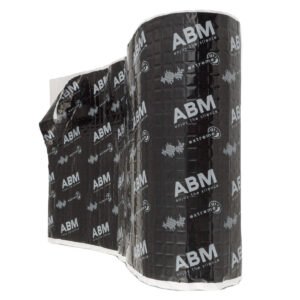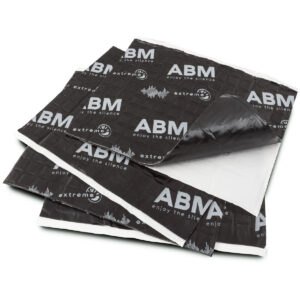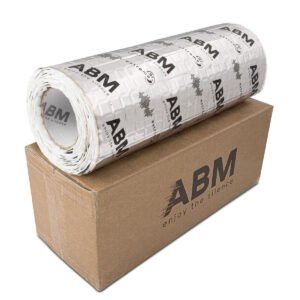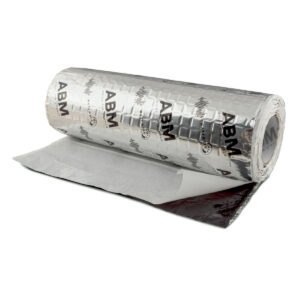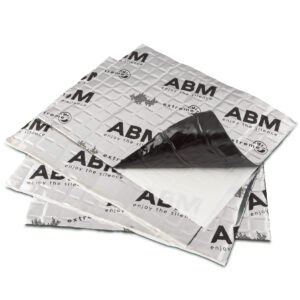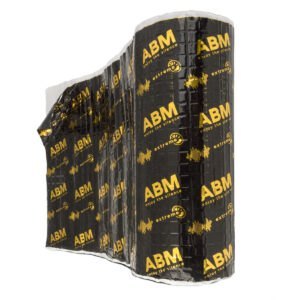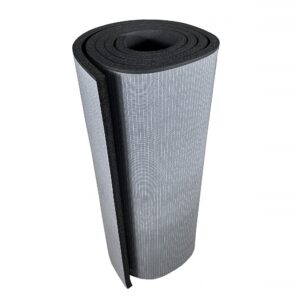Car soundproofing has become a popular procedure, especially among drivers who value driving comfort. A quieter cabin, fewer vibrations, and better acoustic insulation undoubtedly enhance the quality of travel. However, many vehicle owners wonder whether the additional kilograms of mats and foams will affect fuel consumption. This question is justified because any modification that increases the vehicle’s weight can impact its performance and operating economy.
The answer is not straightforward. On one hand, added weight does increase energy demand during acceleration and uphill driving. On the other hand, a quieter cabin may lead to a calmer driving style, which partially offsets the negative impact of the extra weight. A comprehensive approach to the topic requires analyzing several aspects related to driving physics, the type of materials used, and individual driving style.
The actual impact of soundproofing on fuel consumption mainly depends on three factors. The first is the weight of the added materials, the second is their placement in the vehicle, and the third is the driving style after modification. Most studies and user experiences indicate that the increase in fuel consumption is minimal and often difficult to notice during everyday use.
Why additional weight from soundproofing increases fuel consumption
Every extra kilogram in a vehicle requires more energy to set it in motion. The law of physics concerning inertia operates relentlessly. The engine must do more work to accelerate a heavier car to a given speed. Similarly, when driving uphill, increased weight translates into greater power demand.
The relationship between weight and fuel consumption has been the subject of many industrial studies. Car manufacturers have long aimed to reduce their models’ weight by using lighter construction materials. These efforts lead to measurable fuel savings. Research has shown that reducing a vehicle’s weight by 100 kilograms can lower fuel consumption by about 0.4 liters per 100 kilometers.
The mechanism by which additional weight affects fuel consumption works both ways. If reducing weight leads to savings, then increasing it must result in higher consumption. However, the scale of this phenomenon depends on many variables, including engine type, displacement, and driving conditions.
The impact of a dozen or so kilograms of bituminous mats on fuel consumption
Typical vehicle soundproofing using bituminous or butyl mats increases weight by 15 to 35 kilograms. The exact value depends on the scope of work and thickness of applied materials. ABM Professional Butyl Mats and ABM Xtreme are available in various thicknesses from 1.3 to 4 millimeters, allowing for mass adjustment according to individual needs.
Practical studies conducted on a 2008 Toyota Corolla showed that adding 45 kilograms of soundproofing materials increased fuel consumption by only 0.1 liters per 100 kilometers. At a fuel price around EUR 1.50 per liter, this means an additional cost of approximately EUR 0.15 for every 100 kilometers driven.
Basic soundproofing materials:
- Traditional bituminous mats with the highest own weight
- Modern butyl mats providing better damping with less weight
- Acoustic foams absorbing high-frequency sounds
- Rubber insulating foams combining acoustic and thermal properties
For comparison, transporting a solid load of the same weight would have the same effect. In practice, kilograms of mats distributed throughout the vehicle have a similar impact as one passenger sitting on the rear seat. This perspective shows that the impact of soundproofing on fuel consumption is not drastic.
Difference in energy demand during acceleration
During acceleration, the engine must overcome the vehicle’s inertia. The greater the mass, the more energy is needed to reach a certain speed. An additional 20 kilograms of soundproofing mats will extend the acceleration time from 0 to 100 kilometers per hour by about 0.2 to 0.3 seconds.
This difference is almost unnoticeable during normal city or highway driving. In practice, the driver will not feel a decrease in vehicle dynamics. The greatest impact of additional mass appears during frequent accelerations typical of aggressive driving style in urban conditions.
It is worth noting that modern cars are designed with some power reserve. Engines easily handle a slight increase in total vehicle mass. Engine management systems automatically adjust operating parameters to ensure smooth driving.
Industry estimates for an increase of 0.1–0.2 liters per 100 km
Automotive experts agree that with typical levels of soundproofing, fuel consumption increases range from 0.1 to 0.2 liters per every 100 kilometers. These estimates are based on practical measurements and analysis of data from many modifications. Studies from various countries confirm these values, showing consistency regardless of vehicle type.
On an annual scale with mileage of 15,000 kilometers, the additional fuel cost will be about 22.50 to 45 EUR. For many drivers, this is an acceptable price for a significant improvement in acoustic comfort. Reducing cabin noise by several decibels significantly affects well-being during driving.
Comparison of factors affecting fuel consumption:
- Underinflated tires can increase consumption by up to 30 percent
- Aggressive driving style raises consumption by 10 to 20 percent
- Soundproofing increases consumption by a maximum of 2 to 3 percent
- Fuel quality can affect consumption by 5 to 10 percent
It should be remembered that variables such as tire pressure, driving style, or fuel quality have a much greater impact on fuel consumption than an additional 20 kilograms of mass. Underinflated tires can increase fuel consumption by up to 30 percent. Aggressive driving raises consumption by 10 to 20 percent.
Effects compensating for increased fuel consumption after soundproofing
Soundproofing a vehicle not only increases its mass but also affects driver behavior and interior conditions. A quieter interior changes perception of speed and engine operation. Drivers in soundproofed vehicles often do not clearly hear engine revolutions, which leads to a more balanced driving style.
Reducing noise levels in the cabin translates to lower stress and fatigue. Studies show that prolonged exposure to noise above 70 decibels negatively affects concentration and well-being. A quieter cabin allows for better focus on the road and traffic.
Thermal insulation, which often accompanies soundproofing materials, can additionally contribute to energy savings. Better insulation limits heat loss in winter and cabin heating in summer, reducing the load on the heating and air conditioning system.
Calmer driving style thanks to improved acoustic comfort
A quieter cabin results in a more relaxing drive. Drivers in soundproofed vehicles less frequently perform sudden maneuvers and aggressive accelerations. The absence of annoying noise eliminates the need to “escape” acoustic discomfort by driving faster.
Research has shown that drivers in quieter cars more often maintain a steady speed. Smooth driving at a constant speed is the most economical way to travel. Avoiding frequent acceleration and braking significantly reduces fuel consumption.
Factors influencing driving style:
- The noise level in the cabin determines the driver’s acoustic comfort
- Better audio system audibility allows for lower volume levels
- Reduced fatigue results in better concentration on the road
- The absence of irritating noise limits stress during driving
A calmer driving style can compensate for, and sometimes even exceed, the slight increase in fuel consumption resulting from additional weight. The difference between aggressive and calm driving styles often amounts to 0.25 to 0.5 gallons per 62 miles.
Reducing air conditioning load through additional thermal insulation
The materials used for soundproofing also have thermal insulation properties. ABM Professional butyl mats and ABM Xtreme effectively insulate the vehicle interior from extreme external temperatures. ABM Insulation rubber foam provides an additional thermal barrier.
In summer, thermal insulation slows down the heating of a parked car’s cabin. The air conditioning does not have to work as hard to cool the interior. In winter, insulation helps retain heat inside the cabin, reducing heating time and power.
Air conditioning and heating are among the largest energy consumers in a car. Intensive air conditioning use can increase fuel consumption by up to 0.25 gallons per 62 miles. Better thermal insulation limits this effect, bringing tangible savings.
Reducing driver fatigue during long trips
Noises are one of the main factors causing fatigue during long journeys. Continuous exposure to high-frequency sounds and vibrations leads to increasing feelings of exhaustion. A soundproofed cabin significantly reduces this problem.
Less fatigue means better concentration and faster reactions in situations requiring quick decision-making. A well-rested driver travels more safely and economically. There is no need for frequent rest stops, which shortens the total travel time.
Acoustic comfort also affects the passengers’ well-being. A quieter cabin allows for free conversation without raising one’s voice. Children fall asleep more easily during the trip, which further increases the comfort of the ride for all travelers.
Tip: Regularly checking tire pressure has a much greater impact on fuel consumption than the weight of soundproofing materials. Underinflated tires can increase fuel consumption by up to 30 percent, while soundproofing rarely raises consumption by more than 2 percent.
Practical measurements of soundproofing’s impact on driving economy
Measurements of the actual impact of soundproofing on fuel consumption face a number of methodological challenges. Fuel consumption varies depending on many factors such as ambient temperature, wind speed, traffic intensity, or even atmospheric pressure. Isolating the effect of mass alone from other variables requires precise testing conditions.
Practical experiments most often involve comparing fuel consumption before and after modification while driving the same route. Ideally, they should be conducted on the same day under similar weather and traffic conditions. Even with these conditions maintained, results may vary slightly.
Modern car onboard computers display average fuel consumption with an accuracy of up to 0.1 liters. However, this precision can be misleading because the measuring devices themselves have a margin of error. Additionally, algorithms calculating fuel consumption may be calibrated differently by various manufacturers.
Natural variability of fuel consumption in everyday use
Fuel consumption under real conditions undergoes significant fluctuations. The same driver driving the same route can observe differences ranging from 0.5 to 1 liter per 100 kilometers depending on the day. Traffic intensity, engine temperature, or even road surface condition affect the final result.
Seasonal temperature changes have a significant impact on fuel consumption. In winter, consumption increases due to longer engine warm-up times and denser air. In summer, air conditioning operation also raises fuel usage. Differences between seasons can reach even 1 to 1.5 liters per 100 kilometers.
Factors influencing natural fluctuations in fuel consumption:
- Ambient temperature can change fuel consumption by 10 to 20 percent
- Wind speed and direction affect aerodynamic drag
- Road surface condition determines tire rolling resistance
- Traffic intensity forces different driving styles
Driving style is crucial for fuel consumption. Aggressive acceleration, frequent braking, and high-speed driving dramatically increase fuel usage. The difference between calm and dynamic driving can be as much as 20 to 30 percent.
Difficulty in Detecting Differences Below 0.2 Liters
An increase in fuel consumption of 0.1 to 0.2 liters per 100 kilometers falls within the range of natural measurement variability. Detecting such a small difference requires conducting many measurements under controlled conditions. A single test drive will not provide reliable data.
Drivers often report that after soundproofing, they did not notice any difference in fuel consumption. The onboard computer shows the same values as before the modification. This scenario is very likely, considering the margin of measurement error and natural fluctuations in fuel consumption.
Professional measurements on chassis dynamometers allow for a more precise determination of the impact of additional weight. Controlled conditions eliminate most external variables. However, even such tests show that differences are minimal and often barely detectable.
Comparison of Consumption Before and After Modification Under Different Conditions
The most reliable comparisons include measurements in various driving scenarios. The test should cover city driving, suburban routes, and highway driving. Each of these conditions places different demands on the vehicle and engine.
In city traffic, where frequent acceleration and braking dominate, the impact of additional weight is most noticeable. The engine must repeatedly accelerate a heavier vehicle from near zero speed. Under these conditions, the increase in fuel consumption can reach the upper limit of industry estimates.
| Driving Conditions | Increase in Fuel Consumption | Dominant Factor |
|---|---|---|
| City | 0.15–0.25 l/100 km | Frequent accelerations |
| Rural Road | 0.10–0.15 l/100 km | Mixed conditions |
| Highway | 0.05–0.10 l/100 km | Air resistance |
On the highway at a constant speed, the impact of mass is significantly smaller. After reaching cruising speed, the main resistance is air resistance, which does not depend on the vehicle’s mass. Under these conditions, the difference in fuel consumption can be practically undetectable.
Tip: The most accurate measurements of the impact of soundproofing on fuel consumption can be obtained by filling a full tank before and after modification, then driving exactly the same route under similar weather and road conditions.
Optimal placement of soundproofing materials in the vehicle
The way soundproofing materials are arranged matters not only for acoustic efficiency but also for maintaining the vehicle’s driving characteristics. Concentrating mass in inappropriate places can negatively affect car handling. Even distribution of materials minimizes adverse effects.
Mass placed low, close to the vehicle’s center of gravity, has the least impact on driving dynamics. Materials installed on the floor or lower parts of the doors stabilize the vehicle. Conversely, additional mass on the roof or high up on pillars can raise the center of gravity, which worsens cornering performance.
Professional shops specializing in vehicle soundproofing use a strategy of selective material placement. The heaviest bituminous mats are installed in the lower parts of the bodywork. Lighter acoustic foams go to higher locations such as the roof or pillars.
Placing mass low to preserve driving characteristics
A low center of gravity is key to good vehicle handling. Car manufacturers invest millions to lower the point around which the vehicle’s mass rotates when cornering. Adding mass low near the floor does not worsen and sometimes even slightly improves stability.
The vehicle floor is a natural place for the heaviest butyl mats. The surface is flat and easily accessible. Installing mats on the floor effectively reduces road noise, which is one of the main sources of uncomfortable sounds. ABM Professional butyl mats are available in various thicknesses, allowing you to adjust mass according to needs.
Optimal locations for heavy butyl mats:
- Passenger cabin floor reduces noise from road and exhaust system
- Sills and lower parts of doors block sounds from outside
- Trunk floor dampens noise from rear axle and wheel arches
- Bulkhead between cabin and engine compartment isolates mechanical noises
Soundproofing sills and lower door parts also brings acoustic benefits without negatively affecting handling. These body areas are particularly exposed to external noise penetration. Additionally, reinforcing doors with mats can improve their sealing and closing stability.
Avoiding excessive loading of roof and pillars
The car roof is where additional mass has the greatest negative impact on handling. Every kilogram mounted high raises the vehicle’s center of gravity. This results in greater body roll when cornering and worsened response to sudden maneuvers.
Roof soundproofing is often desired due to wind noise on highways and rain hitting the metal. The solution is to use lighter materials, such as thin acoustic absorbing foams. These foams effectively dampen sounds with significantly less weight than heavy butyl mats.
Body pillars also require a moderate approach. Excessive weighting of the A, B, and C pillars can affect the torsional stiffness of the body. Lightweight insulating rubber foams are a better choice here than thick bituminous mats.
Even distribution of materials in the cabin
Asymmetric placement of materials can lead to uneven suspension loading. One side of the vehicle becomes heavier than the other, resulting in uneven tire wear and worsened handling. Materials should be installed symmetrically on both sides of the vehicle.
Even coverage of all surfaces provides the best acoustic results. Noise penetrates through the weakest points, so leaving parts of the body without insulation significantly reduces the effectiveness of the entire modification. It is better to apply a thinner layer over a larger area than a thick layer locally.
Strategy for even distribution:
- Materials installed symmetrically on both sides of the vehicle
- Proportional surface coverage depending on noise levels
- Priority for areas with the greatest sound penetration
- Filling insulation gaps with lightweight foams
The installation sequence also matters. Professionals start from the floor, moving through the doors, up to the roof and trunk lid. This order allows control over the total added weight at each stage of work.
Tip: Before starting soundproofing, it is worth weighing the vehicle and checking the maximum gross weight allowed by the manufacturer. Make sure that after adding soundproofing materials and typical cargo, the vehicle does not exceed this value.
Choosing soundproofing materials with minimal impact on fuel consumption
The soundproofing materials market offers a wide range of products with various properties and parameters. Informed consumers can minimize the modification’s impact on fuel consumption by selecting appropriate materials. The key is finding a balance between acoustic efficiency and weight.
Modern materials provide better noise reduction with less thickness and weight. The production technology of butyl mats has evolved significantly in recent years. Premium-class products offer better acoustic parameters than traditional bituminous mats at lower own weight.
The acoustic effectiveness of a material does not always correlate linearly with its weight. Some lightweight absorbing foams provide excellent high-frequency noise reduction despite their low mass. Their use combined with butyl mats on critical surfaces yields optimal results.
Modern, lighter alternatives to traditional mats
Traditional bituminous mats containing asphalt are characterized by high density and significant weight. Modern butyl mats, such as ABM Professional and ABM Xtreme, use advanced polymers instead of asphalt. The result is a lower weight while maintaining or even improving damping properties.
Premium class ABM Xtreme butyl mats offer exceptional effectiveness with relatively low weight. They feature high flexibility and a strong adhesive layer that eliminates the need for heating during installation. The absence of asphalt in the composition prevents cracking and guarantees durability for many years.
Comparison of weights of various soundproofing materials:
- Traditional 4-millimeter thick bituminous mat weighs about 1.25 kilograms per square meter
- 2-millimeter thick ABM Professional butyl mat weighs about 0.75 kilograms per square meter
- 20-millimeter thick acoustic absorbing foam weighs less than 0.25 kilograms per square meter
- 10-millimeter thick insulating rubber foam weighs about 0.375 kilograms per square meter
Acoustic absorbing foams are an excellent complement to butyl mats. Their low density adds minimal weight while providing very good insulation against high-frequency sounds. The open-cell structure absorbs sound waves and eliminates echo inside the cabin.
Butyl Soundproofing Mats ABM Xtreme in the ABM Insulation store
ABM Xtreme Premium Self-adhesive Butyl Soundproofing Mat in rolls, 2.5mm, 2m2
Acoustic Butyl Mat Self-adhesive ABM Xtreme Premium in rolls, 2.0mm, 2m2
Comparison of acoustic efficiency relative to weight
The most rational approach is to analyze the ratio of acoustic efficiency to material weight. This parameter shows how many decibels of noise reduction we achieve per each added kilogram of weight. Modern materials significantly outperform traditional solutions in this comparison.
ABM Xtreme butyl mats provide noise reduction of several decibels even at weights much lower than traditional bituminous mats. High efficiency results from the use of a butyl damping layer and aluminum foil, which additionally provides thermal insulation.
| Material | Mass (kg/m²) | Noise Reduction (dB) | Efficiency (dB/kg) |
|---|---|---|---|
| ABM Insulation Butyl Mat Xtreme 2mm | 3.0 | 6–8 | 2.0–2.7 |
| Acoustic Foam 20mm | 0.8 | 3–5 | 3.8–6.3 |
| Rubber Foam 10mm | 1.5 | 4–6 | 2.7–4.0 |
Sound-absorbing acoustic foams, despite their very low weight, effectively eliminate high-frequency sounds and echo. Their pyramid or wave structure increases the absorbing surface area with minimal material usage. Using foams in combination with butyl mats creates a synergy effect.
Insulation Rubber Foams in the ABM Insulation store
Soundproofing rubber foam with aluminum foil ABM – 10mm, 1m2
Moderate soundproofing of doors and floor as a compromise
For drivers seeking an optimal compromise between acoustic comfort and minimal impact on fuel consumption, selective soundproofing is the best solution. Focusing on key areas such as doors and floor provides significant improvement with limited added weight.
Doors are one of the main points where noise penetrates the cabin. Soundproofing their inner panels and technological openings brings a noticeable improvement in acoustic comfort. Typical soundproofing of four doors requires about 2 to 3 kilograms of butyl mats.
The cabin floor is the second priority area. Noise from the drivetrain, suspension, and road surface penetrates through the floor. Applying butyl mats over the entire floor surface adds about 2.5 to 3.75 kilograms of weight, providing significant noise reduction.
The importance of material quality for long-term economy
Choosing high-quality materials translates into long-term economic benefits. Cheap, low-quality products may lose their properties over time, peel off, or even emit unpleasant odors. The result is the need to repeat work, generating additional costs.
Premium-class materials, such as ABM Xtreme and ABM Professional butyl mats, come with a five-year manufacturer’s warranty. Their durability and resistance to extreme temperatures ensure property retention throughout the vehicle’s service life. A one-time investment in quality pays off through years of trouble-free use.
Long-term benefits of quality materials:
- Retention of damping properties throughout the service life
- Resistance to extreme temperatures from minus 40 to plus 80 degrees Celsius
- No emission of harmful substances at high temperatures
- Manufacturer’s warranty covering potential material defects
The non-toxic composition of modern butyl mats eliminates the risk of emitting harmful substances at high temperatures. Resistance to moisture and mold prevents bacterial growth inside the bodywork. These features directly affect passenger health and vehicle resale value.
Tip: Purchasing materials from reputable manufacturers, such as ABM Insulation, guarantees high product quality and technical support during installation. Saving on material quality often leads to the need for redoing work in the future.
FAQ: Frequently Asked Questions
Does soundproofing increase a car’s aerodynamic drag and affect fuel consumption?
Internal soundproofing of a car does not affect the vehicle’s aerodynamic drag. The materials are installed inside the body without changing the car’s external shape. The impact on fuel consumption comes solely from the added weight, not aerodynamics. Air resistance remains unchanged regardless of the number of soundproofing mats in the cabin.
Even with comprehensive soundproofing, the external lines of the body remain identical. All materials are hidden under upholstery and carpeting. The drag coefficient does not change, so at a constant highway speed, any difference in fuel consumption is due only to weight.
By how many kilograms does a car’s weight increase after standard soundproofing?
Standard soundproofing of a passenger car increases weight by 3.75 to 6.25 kilograms. The exact value depends on the vehicle size and scope of work. Soundproofing four doors adds about 2 to 3 kilograms, while the cabin floor adds another 2.5 to 3.75 kilograms. Wheel arches and trunk add an additional 1.25 to 2.5 kilograms of soundproofing materials.
Comprehensive soundproofing including roof, pillars, and bulkhead can increase weight by up to 8.75 kilograms. Modern butyl mats are lighter than traditional bituminous ones. Choosing appropriate materials helps minimize impact on vehicle weight.
Does soundproofing affect driving safety and vehicle handling?
Soundproofing can slightly affect vehicle handling characteristics. Additional weight extends braking distance by a few centimeters when braking from 62 miles per hour. Acceleration from 0 to 62 miles per hour is prolonged by 0.2 to 0.3 seconds.
The most important factor is material placement in the vehicle. Weight mounted low near the floor stabilizes the vehicle. Excessive loading of the roof can raise the center of gravity and worsen cornering performance. Professional soundproofing considers even mass distribution without negatively impacting safety.
How much does car soundproofing cost, and what acoustic effect does it provide?
The price of soundproofing depends on scope of work and material quality. Soundproofing two doors costs from €175 to €375. Comprehensive noise reduction for an entire vehicle requires a budget from €1000 to €5000. The most expensive are premium materials and complex geometry of luxury cars requiring precise fitting.
The acoustic effect is measurable and significant. Professional soundproofing reduces cabin noise by 3 to 8 decibels depending on area treated. A reduction of 3 decibels means halving perceived noise levels. The greatest effect is achieved by soundproofing doors and floor, which block main sources of noise penetration.
Can a Quieter Cabin Compensate for Increased Fuel Consumption?
A quieter cabin can indeed contribute to fuel savings by changing driving style. Drivers in soundproofed vehicles more often maintain a steady speed and perform aggressive maneuvers less frequently. The absence of annoying noise eliminates the need to “escape” acoustic discomfort by driving faster.
A calmer driving style can save from 0.13 to 0.38 gallons of fuel per 62 miles. The difference between aggressive and economical driving often amounts to 10 to 20 percent of fuel consumption. Additionally, better thermal insulation reduces air conditioning work, which also translates into savings. In practice, compensating effects may outweigh the slight increase in fuel consumption caused by the additional weight of materials.
Summary
Car soundproofing does affect fuel consumption, but the scale of this impact is much smaller than common opinions suggest. Typical comprehensive soundproofing increases vehicle weight by 33 to 77 pounds, which translates into an increase in fuel consumption of about 0.03 to 0.05 gallons per 62 miles. In practice, this difference often falls within the natural variability of measurements and is difficult to detect during daily use.
The key factor is the way materials are arranged and their selection in terms of acoustic efficiency relative to weight. Modern ABM Professional and ABM Xtreme butyl mats offer excellent noise damping with relatively low own weight. Supplementing them with lightweight absorbing acoustic foams and insulating rubber foams allows achieving excellent results with limited impact on fuel consumption.
It should be remembered that compensating effects can partially or completely offset the slight increase in fuel consumption. A quieter cabin encourages a calmer driving style, which can lead to savings exceeding the cost of additional weight. Better thermal insulation reduces the load on air conditioning and heating, which also helps keep fuel consumption at a reasonable level. Acoustic comfort, fatigue reduction, and improved travel quality are significant benefits whose value definitely outweighs the minimal increase in fuel costs.
Sources:
- https://natural-resources.canada.ca/sites/www.nrcan.gc.ca/files/oee/pdf/transportation/fuel-efficient-technologies/autosmart_factsheet_16_e.pdf
- https://en.wikipedia.org/wiki/Fuel_economy_in_automobiles
- https://en.wikipedia.org/wiki/Fuel_efficiency
- https://www.sciencedirect.com/science/article/abs/pii/S1361920924001147
- https://www.sciencedirect.com/science/article/abs/pii/S136192090900011X
- https://www.sciencedirect.com/science/article/pii/S2090447924003320
- https://yadda.icm.edu.pl/baztech/element/bwmeta1.element.baztech-9efa97f3-f62a-4734-9c08-9d69083bd22d/c/at2024_4_gonera_janulin_i-in_effect_of_vehicle.pdf
- https://www.archivesoftransport.com/index.php/aot/article/view/664
- https://pmc.ncbi.nlm.nih.gov/articles/PMC9099554/
- https://journals.sagepub.com/doi/full/10.1177/16878132251345867
- https://core.ac.uk/download/pdf/620872490.pdf
- https://www.oecd.org/content/dam/oecd/en/publications/reports/2022/09/projecting-the-fuel-efficiency-of-conventional-vehicles_2b2b6374/13b94818-en.pdf


